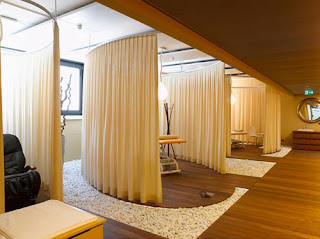‘The time for timber has come’ declared Craig White of White Design, the chair for the evening. The need for low embodied energy in construction materials is becoming increasingly important and the use of timber to achieve this is a no-brainer.
John Hope Gateway - Edward Cullinan Architects
The presentation of the John Hope Gateway at the Edinburgh Botanical gardens, by Edward Cullinan Architects was skilfully delivered by Roddy Languir. He described how the existing routes and views were analysed, and formed the conceptual basis of the design along with props, planes, spiral and canopy with arboreal references throughout.
In this instance timber is used as a sustainable, low-energy material forming part of an environmental solution working within the context of its botanical surroundings. Its exposed glulam beams elegantly jointed to steel columns form the ‘canopy’ under which visitors can sit and enjoy framed views of the gardens.
Gordon Cowley of Cowley Timberworks presented ‘Geometrically challenged structures’ through a wonderful array of creative timberwork from geodesic domes (Napier University, Bradford Royal Infirmary) to the ‘tensegrity structure’ of the Cutty Sark Pavilion.
The message was clear; in a country whose local timber resource is scarce, the less wood we use within a structure the better. Efficiency within the structure is key, where beauty lies within the ingenuity and pure simplicity of the resultant form.
Southall Gurdwara
The complex timber structure of the canopy which overhangs in areas by 20m, is an achievement in constructional ingenuity, and would not have been possible 20 years ago even though it utilizes ancient building techniques. The result is an iconic building which effectively connects a new site for urban development with the main city across a major railway, by framing views and being a destination in itself.
 |
| Pompidou centre metz |
The Pompidou Centre may be extravagant, and the elegance achieved in Shigeru’s smaller projects lost within a complexity at a scale too large for most of us to comprehend. Efficiency does not seem to have been factored in the process of the design, and although there are a number of token gestures toward the environmental performance of the building, this is in contrast to the indulgence of the sheer size and complexity of the undulating ‘woven’ timber roof.
Timber is a beautiful and sustainable material which appeals to our senses. Using timber in innovative ways can awe and inspire provided that it is used in an honest and comprehensible way. If we are to promote the use of timber for the future of our built environment, we must not lose sight of its integral characteristics.
If we make an effort to understand the material and its sustainable qualities then we are a step closer to realising its full potential. The boundaries are now being pushed in a direction where timber has become exciting as well as the natural choice for a sustainable solution proving that it is indeed the time for timber.






